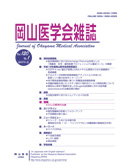

Journal of Okayama Medical Association
Published by Okayama Medical Association<Availability>
Full-text articles are available 3 years after publication.
Permalink : https://ousar.lib.okayama-u.ac.jp/14234
Persistent herpes simplex virus type 2 infection in a hamster kidney cell line with a characteristic to grow at a high culture temperature
Kitamura, Tetsuro
Published Date
1991-08
Abstract
A subline of the baby hamster kidney cell line (BHK-21), which was adapted to grow at 41℃ and named BHK-21H, was used to examine the effect of pre-treatment of host cells with a high culture temperature on the growth of herpes simplex virus (HSV). BHK-21H cells were infected with HSV type 2 (HSV-2) at 41℃ and maintained for 7 days at the same temperature. When these cells were further cultivated after shift-down to 36℃, persistent infections were established. These infections were characterized by a carrier culture state ; the infected cultures were composed of infected and non-infected cells, and cell destruction and regrowth of cells caused a balanced state of culture. Two to 3 months after the establishment of the persistent infections, virus production in the cultures stopped spontaneously and colonial regrowth of uninfected cells was observed. A subline (BHK-21R) which was cured of the persistent infection was obtained. Cells of this subline showed resistance to reinfection of HSV. Persistent HSV-2 Infection was also established by pre-treatment of BHK-21H cells at 41℃ before virus infection and maintenance of the infected cultures at 36℃. These findings indicate that establishment of the persistent HSV-2 infection is mainly attributable to reduced permissiveness of BHK-21H cells for virus growth caused after heat treatment of the cells.
Keywords
herpes simplex virus
persistent infection
supraoptimal temperature
carrier culture state
permissiveness
Note
原著
ISSN
0030-1558
NCID
AN00032489
